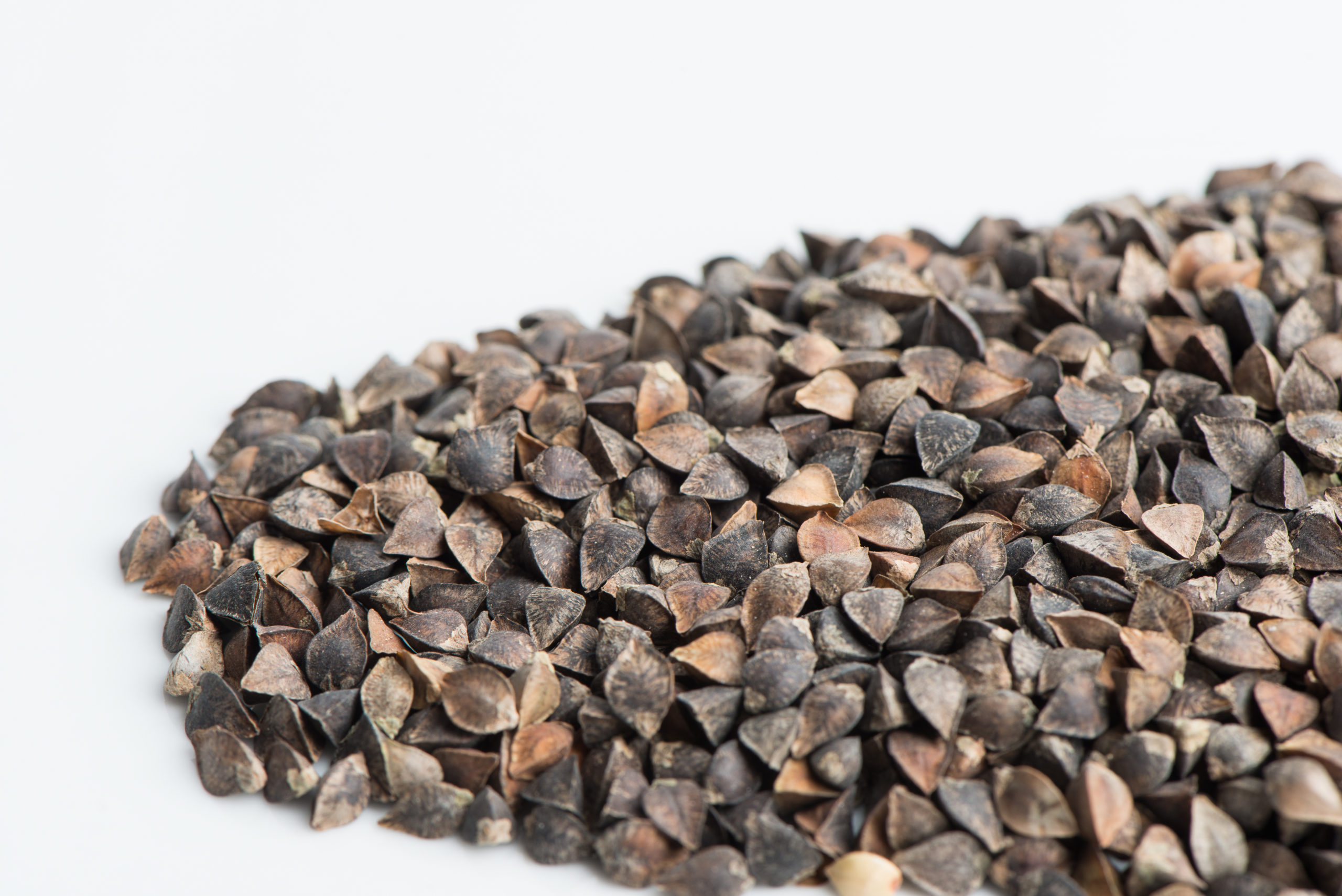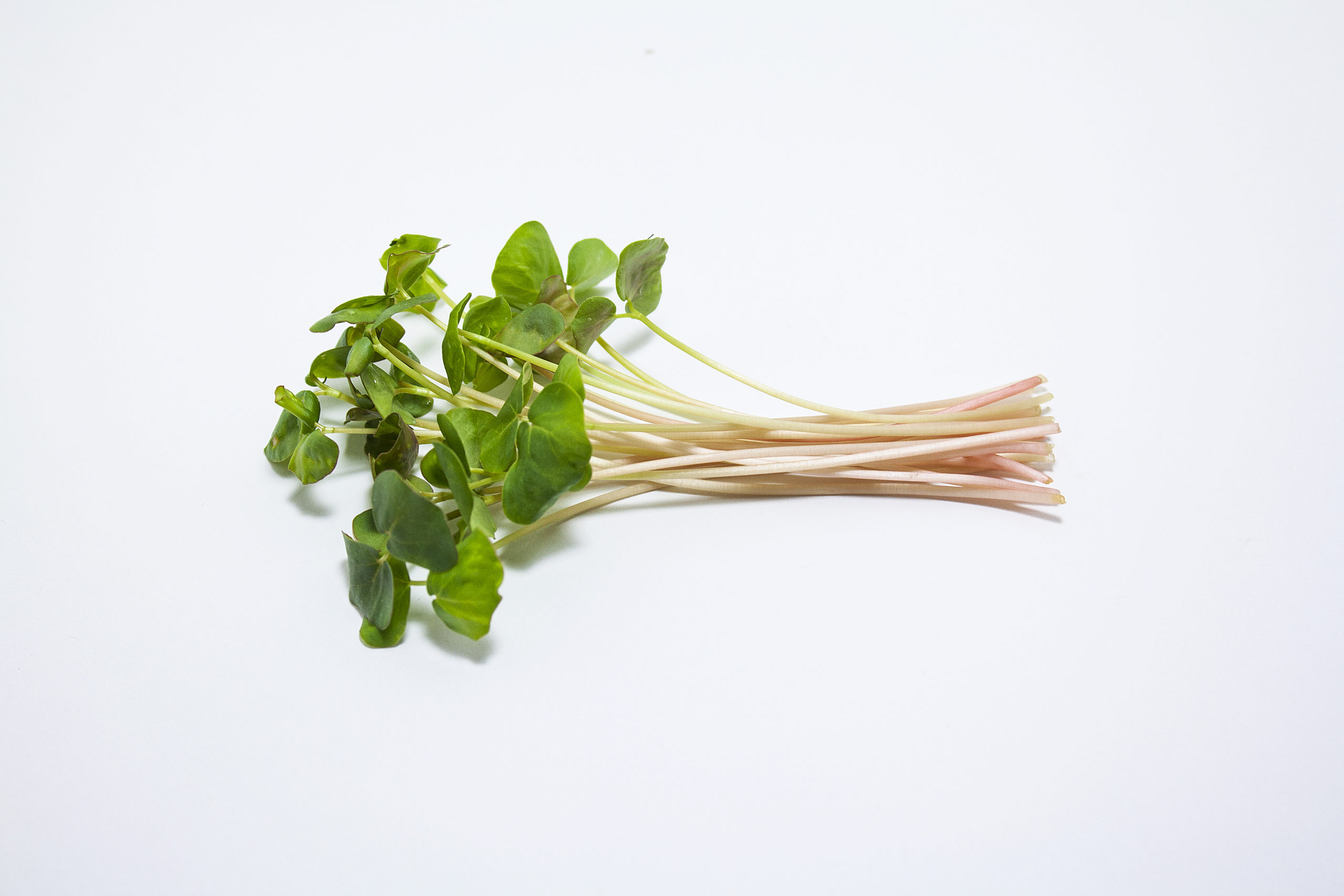Buckwheat‚ Hulls On
The microgreens are often referred to as buckwheat lettuce for their fresh, lettuce-like flavour.
Consumption of very large amounts of buckwheat greens as juice has been linked to temporary photosensitization of skin. Until more information is available, we recommend moderate use.
- Days to Sprout: 10 to 12 Days
- Soak Time: 6-12 hours
- Yield: 1/2 cup of dry seed yields approx. 5 cups of sprouts.
- Method: Soil only
- Storage: Our seeds should sprout well for a year after you purchase them, if stored in a cool dry place. If you’d like to extend the germination life of your seeds, store them in the fridge. If you store your seeds in the freezer, they’ll last even longer!
Grow Buckwheat Lettuce!
Soak. Using a tray with drainage holes, rinse enough seed to cover the bottom of the tray. Soak the seed for 4-12 hours. Use a jar with a sprouting lid for soaking if the tray holes are too large. Drain, rinse and drain holding at an angle to remove excess water. Spread the seed evenly on the bottom of the tray and cover with a lid top and bottom or put in plastic bag.
Rinse. Rinse with cold water twice a day, using either a gentle flow from a tap, dipping in a sink, or spraying. Drain thoroughly.
Grow. The roots will form a mat from which the microgreens will emerge. At that point, put in indirect sunlight, florescent/LED lights or grow lights. The watering is then easy: fill the container 1 cm deep with water and allow to sit for a few seconds in the water and then tilt on an angle to decant the water until only some moisture is remaining in the root area. Continue to rinse twice a day as described above.
Harvest!
Typically, microgreens grown without soil are harvested at 7-10 days. Harvest before the next expected rinse so the shoots are dry. Harvest microgreens using scissors or knife.
Instead of harvesting all at once, you can start to harvest microgreens as soon as the first two leaves are spread out. Take only what you need for your meal and allow the rest to keep growing or put the tray in the fridge loosely covered and a plastic bag or dome to harvest.
Grow Buckwheat Lettuce! (Directions for soilless microgreens)
Soak. Using a tray with drainage holes, rinse enough seed to cover the bottom of the tray. Soak the seed for 4-12 hours. Use a jar with a sprouting lid for soaking if the tray holes are too large. Drain, rinse and drain holding at an angle to remove excess water. Spread the seed evenly on the bottom of the tray and cover with a lid top and bottom or put in plastic bag.
Rinse. Rinse with cold water twice a day, using either a gentle flow from a tap, dipping in a sink, or spraying. Drain thoroughly.
TIP: Sunflowers grow really well if the roots are in about ¼” water and changed daily. You can do this by placing your growing tray inside another tray filled with ¼” water. Mist and cover the sunflowers with a clear dome or loose plastic to help remove the hulls.
Grow. The roots will form a mat from which the microgreens will emerge. At that point, put in indirect sunlight, florescent/LED lights or grow lights. The watering is then easy: fill the container 1 cm deep with water and allow to sit for a few seconds in the water and then tilt on an angle to decant the water until only some moisture is remaining in the root area. Continue to rinse twice a day as described above.
Harvest!
Typically, microgreens grown without soil are harvested at 7-10 days. Harvest before the next expected rinse so the shoots are dry. Harvest microgreens using scissors or knife.
Instead of harvesting all at once, you can start to harvest microgreens as soon as the first two leaves are spread out. Take only what you need for your meal and allow the rest to keep growing or put the tray in the fridge loosely covered and a plastic bag or dome to harvest.
You will need:
• 10” x 20” gardening trays (1-inch-tall preferred), 1 with holes + 1 without. Smaller microgreen trays also work well.
• Good quality organic starting soil mix
• Parchment paper or unbleached paper towel,
• Dome lids (clear or black) or plastic sheet
• Organic seed
• Mister bottle, cup measures, garden spray nozzle (optional)
• Scissors or sharp knife
1. Soak the Seed
Larger seed such as sunflower, buckwheat, microgreen salad mix, wheat and peas should be washed then soaked in water for 6 – 12 hours prior to seeding. Drain, rinse and drain the seed after soaking.
2. Prepare Soil
Add water to top of the bag (or each tray) 12 hours ahead of use until almost fully hydrated. Rehydrate the bag as necessary. If you were to put the soil in your hand and squeeze it, you should not be able to get much more than a drop of water out of it for the perfect moisture content. If you want to mist the seed after putting it on the soil, reduce the water hydration of the bagged soil a bit.
TIP: To check for overwatering, tip the tray to one end. Water should not pool enough to drip out of the tray.
3. Fill Trays with Soil
Use a tray with holes. Fill with 3/4-1.5” of soil. The closer to the top of the tray the better aid to air circulation. Use a block or your hand to smooth and flatten the soil without compacting it. The back of a tablespoon or spatula smooths out the valleys. You can wait to put the tray without holes under until after unstacking/uncovering or add it to the bottom now.
TIP: Place a layer or two of paper towel on the bottom of the tray before adding soil for easier cleanup.
4. Sow the Seed
Spread the soaked seed evenly over the soil in the tray. The seeding density depends on the stage at which you’re planning to harvest. You should have one layer of seeds, side by side and mostly not overlapping. Spread out any clumps with a spoon or your hands. Sow slightly less seed for 2-3 week microgreens.
5. Cover the Seed
Doing away with soil as a seed cover decreases the work and time it takes to grow the greens. If stacking the trays on top of each other, use a cover directly on the seed like parchment paper, a plastic sheet or wet unbleached paper towel layer. When not stacking trays, the seed will need protection from drying out by using a dome/lid. Use a clear dome or an inverted 10 x 20” tray without holes. For smaller trays, use several layers of unbleached paper towels folded onto itself with or without a plastic sheet covering the top.
TIP: Most microgreens will grow taller when you keep the light out at the beginning, but this may make the stem weaker. Most seeds germinate in the light no problem.
6. Stack Trays
Stacking helps to quickly force the roots into the soil, provides darkness, promotes even germination/growth. Stack 2-5 filled trays on top of each other with an empty tray on the top of the stack with a weight in it. Check at least once a day to see if the trays need water. Stack for 3-5 days. Sunflowers stay stacked the longest -5 days. Put no holes trays under the soil filled holed trays.
7. Expose to Indirect Sunlight, Florescent/LED or Grow Lights.
After 2-5 days, the microgreens should be ready for light. If the microgreens begin to get quite tall and leggy, this is an indication that they may need a bit more light.
8. Water the Growing Microgreens
Check the seed once or twice daily and water as needed. The soil should be moist, not wet. Once trays are unstacked, add water from below into the no holes tray as necessary.
9. Harvest!
Sunflowers, buckwheat, and wheat grass is usually harvested around 9 to 10 days with scissors or a sharp knife. Make sure microgreens are not damp before storing. If needed, you may use a small fan or salad spinner to dry the microgreens before storing in a sealed container in the fridge.
Instead of harvesting all at once, you can start to harvest microgreens as soon as the first two leaves are spread out. Take only what you need for your meal and allow the rest to keep growing or put the tray in the fridge loosely covered and a plastic bag or dome to harvest another day. Water as necessary.
10. Enjoy!
Microgreens make everything better, so have fun with them and add them to your favourite dishes!
Helpful tips:
• To moisten your bag of soil, add water ahead until almost fully hydrated.
• The roots grow under the soil so it works well to water from below if the tray has holes in it, or open the side of the tray and pour water beside the soil when using flexible plastic trays. Otherwise misting or watering from the top works well too.
• To get the hulls to drop from sunflower, beet, chard and buckwheat leaves cover the tray loosely with clear plastic during the last days of growth. Mist the hulls. This will trap enough moisture to soften the hulls to be easily brushed off by hand.
• Good cleaning practices each growing cycle:
Remove debris from trays. Apply soap to a brush and clean all surfaces with suds and firm pressure. Rinse. Sanitize your trays, equipment, tools and surfaces
Sprouting Tray Baby BlanketSoil
While many people think that buckwheat is a cereal grain, it is actually a fruit seed that is related to rhubarb and sorrel making it a suitable substitute for grains for people who are sensitive to wheat or other grains that contain protein glutens. (NOTE: Mumm's cannot guarantee that buckwheat has not come into contact with other grains during the manufacturing process.)Note on photosensitization- information as of August 20, 04 – There is some information indicating that buckwheat shoots in large quantities may cause a reversible photosensitization that includes uncomfortable symptoms. We are currently recommending moderate consumption of buckwheat shoots, and complete avoidance if any light sensitivity occurs. A short article by Gilles Arbour, discoverer of this problem, is available at http://www.gillesarbour.com/buckwheat.php. There is a link to further very detailed information. Aug 15/11- Since first posting this warning in 2004, we have continued to enjoy buckwheat shoots on a regular basis without any of the above symptoms, nor have any of our customers reported any negative symptoms.
See our health benefits page for the latest research and articles on the health benefits of buckwheat shoots: https://sprouting.com/health-benefit/buckwheat-sprouts/



Ugrowgirl –
I use buckwheat as a short sprout, rather than as a lettuce. It producecs delightful sprouts in a couple days, which make a delicious addition to chewy oat sprouts (I often sprout them together, sometimes with sunflower seeds). It is also great as a short sprout on a salad. The hulls add texture. They are also good blended with liquid, and added to batters, where they add that specific delicious buckwheat flavor and a pleasing black speckle and some texture to muffins biscuits and pancakes.
Beat Hegnauer –
I use the Buckwheat as Sprouts and Micro Greens. Easy to work with, and great end product.
Buckwheat King –
Make a pancake mix of 3 heaping tablespoons buckwheat flour , 1 part coconut flour . Blend in 1 egg and just enough high fat, cold , organic milk to make a medium batter . Toss in a scoop of walnuts and a scoop of raisins and 1 teaspoon of baking powder . Thoroughly mix again and on to a very hot grill .
yippeeduck –
Ordered unhulled buckwheat . It arrived in record short time , and , was cleaned to perfection .
Claudine –
I buy these seeds and grind them into flour for baking bread, pancakes, sour dough, etc. also add quinoa seeds.
Dr. Serge –
Finally we found high quality seeds – and for good price. Free delivery a nice bonus!
Already recommended this company and this product to our relatives and friends.
Thank you very much.
Nimmywimmy –
I was so glad to find a Canadian source for buckwheat sprouting seeds. They arrived quickly by mail and so far have been very easy to grow. Delicious on their own or in a mix or even as a garnish.
Eric –
I grow buckwheat as microgreens. It was my first time with buckwheat from Mumm’s. Wow, these are amazing! Much better than seeds purchased in local store. I was totally amazed with how vigorous these are. Highly recommended!
Shelly –
These are growing well on my hemp mats and they are mild – making a good contrast to the more peppery microgreens.
rebecca –
excellente germination
An island grower –
This is so easy to grow. I like it best grown in soil. First I sprout until there are small white tails on the seeds..spread it over an inch of soil and make sure it’s nice and wet. Cover it until it’s about an inch tall and spray it with water twice a day. Uncover and let it grow. I will never buy lettuce again.
Chris –
Grow easily. Good flavor. I add to smoothies too for delicious greens
FuriousT –
Great! Easy to sprout and tasty. The only thing with these is they get a skanky smell no matter how often I rinse clean water through them, maybe that’s normal for buckwheat.
Mike Stawski –
Great selection and fast delivery. Will order from Mumm’s again.
NewbieGardener –
This is my favourite of all the microgreens I have tried so far. They grow nice and tall, they are very pretty (love those dark pink stems), and they are so tender. Great in sandwiches and salads or wilted on top of hot dishes. I have many digestive issues and cannot tolerate lettuces of any kind, so finding this is sheer heaven. I plant small trays often so that I can always keep a few on the kitchen table where we can snip of portions to add to our meals as desired: the buckwheat disappears faster than any other type of microgreen in our house.
Jean Montambeault –
Extremely high rate of germination. Great taste. They do better outside than in as they grow stronger and tastier. Haven’t tried them under grow light yet. That’s about it: very satisfied.
lotte –
Great as a mini green .Very eager & easy yo sprout. Great also in smoothies. Not bitter at all.
10922749 Canada Ltd –
We have been a business client for at least 4 years and have used many of their microgreen seeds for our local indoor microgreens farm.The quality of their seeds is great. The Buckwheat microgreen seeds have never ever disappointed us. We do believe that it can be a challenging microgreen to grow especially with the hulls but once you know how to make sure they are off before harvesting you’re golden. They are beautiful in colour (orangy/pinkish stems) and they taste great and are very mild. We’re grateful to have a great seed vendor available in Canada. We believe it’s great to support local businesses and the environment at the same time. Thanks you, we grately appreciate you!